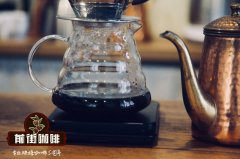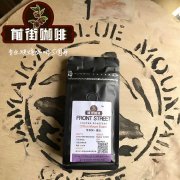Yejia Xuefei production area | Burka Silinga Black Lattice skirt treatment Plant Flavor of Local Native species of washed beans

Professional coffee knowledge exchange more coffee bean information please follow the coffee workshop (Wechat official account cafe_style)
Yega Xuefei production area | what is the flavor of the native species of washed beans in the Burka Silinga black plaid skirt treatment plant?
The black plaid skirt processing plant is located in the famous Yega Xuefei production area in Ethiopia. About 500 farmers hand over their coffee beans to the black plaid skirt cleaning station. Small farmers cultivate about 2.5 hectares, at an altitude of 1850-1900 meters. Farmers must send the harvested coffee to the treatment plant immediately. If it takes more than 4 hours, the coffee will ferment and the taste will become very bad. After the end of the coffee season, the processing farm has to work all night until dawn. If you lose time, you will lose Nong Ming's hard work and money. Coffee cherries are peeled and pulped, then fermented with water for 48 hours, and then dried on a high-priced bamboo bed for 10 days, depending on the face of God.
Yega Xuefei grows in the mountains and forests of the famous Sidamo producing area in southwestern Ethiopia. Coffee beans belong to small and medium-sized particles, the color of raw beans is slightly yellowish green, and the bean shape is beautiful and complete, which is representative of boutique coffee in East Africa.
What Yega Xuefei is most interested in is that it has a unique, obvious sweet and sour fruit, as soon as the entrance, the aroma immediately rushed out, at first there is a pleasant citrus flavor, flavor and jasmine fragrance. "not much like coffee, but a bit like fruit tea" is the common feeling of many people towards medium-shallow roasted Yega Xuefei. Yega Chuefei shows unique lemon, floral and honey-like sweet aromas, soft acidity and citrus flavors, fresh and bright taste, a highly personalized premium coffee, is a high-quality washed Arabica beans.
Growing in a misty valley, this bean has a beautiful name. Many coffee trees are planted in the small town of Yegashafi in Sidamo, Ethiopia. Instead of the sun treatment used by Sidamo ten years ago, farmers in the misty valley turned to washing coffee beans, which also made Yega Xuefei famous. Now, Yejia Xuefei is not only a place name, but also a familiar pronoun for coffee beans.
According to local elders, although Yega Xuefei in the misty valley is famous for its water washing treatment, it is still dominated by traditional sun treatment. because local residents think that sun treatment can give coffee beans an unspeakable flavor. Because of Yejia Xuefei's fame, Suoguo incorporated the coffee-making ceremony into the feast for foreign guests. They did not care whether the beans were complete and full, but directly roasted the beans on an iron plate. As for the taboo of baking beans, there is no need to ask for more at the moment. Under this traditional and wonderful ceremony, even if the beans have different colors, they can still cook an unforgettable taste.
Farm Farm name: Burka Silinga
Farmer Farm owner: Various small producers different kinds of small farmers
City City: Gedeo district
Region producing area: Yirgacheffe Yega Xuefei producing area
Country country: Ethiopia
Altitude altitude: 1850 Murray 1900m
Farm Size Farm area: 500 members
Variety varieties: local traditional varieties of Heirloom
Processing System treatment: Washed washing and drying on the scaffolding
Qianjie recommended cooking:
Filter cup: Hario V60
Water temperature: 90 degrees
Degree of grinding: small Fuji 3.5
Cooking methods: the ratio of water to powder is 1:15, 15g powder, the first injection of 25g water, 25 s steaming, the second injection to 120g water cut off, waiting for the powder bed water to half and then water injection, slow water injection until 225g water, extraction time about 2:00
Analysis: using three-stage brewing to clarify the flavor of the front, middle and back of the coffee. Because V60 has many ribs and the drainage speed is fast, it can prolong the extraction time when the water is cut off.
Important Notice :
前街咖啡 FrontStreet Coffee has moved to new addredd:
FrontStreet Coffee Address: 315,Donghua East Road,GuangZhou
Tel:020 38364473
- Prev

How to steaming coffee by hand in Agualinpa Village, Brazil _ how to distinguish between good and bad hand coffee
Professional coffee knowledge exchange more coffee bean information please follow coffee workshop (Wechat official account cafe_style) Brazilian coffee Agualinpa production area / manor: Agua Limpa altitude: 1050m processing plant / method: coffee Braz / sun flavor description: red wine chocolate hazelnut berry farm introduction: farm full name: Sitio Santa Cruz da Agua
- Next

Ethiopian Red Cherry Project | Xie Like Shilcho Cooperative | G1 washes local native species
Professional coffee knowledge exchange more coffee bean information please follow the coffee workshop (Wechat official account cafe_style) Ethiopian Red Cherry Project | Xie Like Shilcho Cooperative | G1 wash the flavor of local native species? Ethiopia is the country where coffee was first discovered. It is still the most important producer and the best producer in terms of coffee quality and output.
Related
- Detailed explanation of Jadeite planting Land in Panamanian Jadeite Manor introduction to the grading system of Jadeite competitive bidding, Red bid, Green bid and Rose Summer
- Story of Coffee planting in Brenka region of Costa Rica Stonehenge Manor anaerobic heavy honey treatment of flavor mouth
- What's on the barrel of Blue Mountain Coffee beans?
- Can American coffee also pull flowers? How to use hot American style to pull out a good-looking pattern?
- Can you make a cold extract with coffee beans? What is the right proportion for cold-extracted coffee formula?
- Indonesian PWN Gold Mandrine Coffee Origin Features Flavor How to Chong? Mandolin coffee is American.
- A brief introduction to the flavor characteristics of Brazilian yellow bourbon coffee beans
- What is the effect of different water quality on the flavor of cold-extracted coffee? What kind of water is best for brewing coffee?
- Why do you think of Rose Summer whenever you mention Panamanian coffee?
- Introduction to the characteristics of authentic blue mountain coffee bean producing areas? What is the CIB Coffee Authority in Jamaica?

